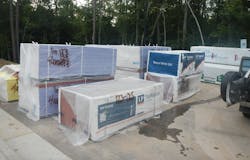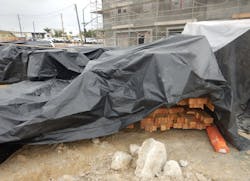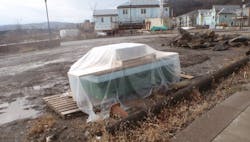In 2018, my colleague John Koenig wrote about how ensuring a clean jobsite makes workers safer and more efficient, and how it tells customers that you, the builder, really do care about quality.
That article focused on the importance of tidying up at the end of each day and emptying the dumpster on a regular schedule. While important, the work of keeping a jobsite clean and well-organized starts further upstream, in the way you handle and store lumber and other building materials.
Too many builders fail to understand this concept. In about half of the 125 or so communities and thousands of new homes under construction I visit in a typical year, I see material handling practices that are not only substandard, but that also cost builders money.
Why So Serious? Damage to Materials Is Real
We all know the problem: Lumber, sheet goods, roof trusses, and even wall panels get left out in the rain, snow, and mud, leading to host of moisture-related issues, such as warping and mold. Rain and snow also cause the breakdown of adhesives, causing wood-based panel products to swell and delaminate.
The direct hard costs are obvious: damaged lumber and panels need to be culled and replaced. The cost per piece may not be high, but it adds up when you’re building a lot of homes. There are also costs from schedule delays while framers wait for replacement materials.
Indirect Costs of Not Properly Storing Building Materials
Other costs are more indirect but just as serious. Builders tell me that homeowners have been getting more and more fussy about seeing materials carelessly strewn around the site, or when they see water-stained, dirty lumber during their framing walk, or even worse, mold. They begin to suspect their builder is careless, which leads to more scrutiny throughout the construction process.
Some homeowners will even take to social media to complain and post photos which, to say the least, doesn’t help the builder’s marketing efforts or reputation.
Easy Solutions for Better Building Materials Storage
These problems are easy to prevent, and the solutions are ones any builder should realize after just a few moments of thought.
For instance, schedule materials deliveries as close as possible to the time those materials will be needed so they spend less time sitting out in the weather or needing to be protected. Make sure the delivery crew puts the stacks of lumber, trusses, and panels on sleepers to hold them off the ground. And keep the materials under cover—in all weather—with plastic sheeting until you need them.
These practices don’t cost money (except maybe for some big tarps). And while they may require that you look at your system for ordering materials and require job supervisors to pay closer attention to material storage, the builders I know who have taken these steps tell me the payoff is well worth that minimal effort.
The bottom line is that when it comes to quality, maintaining a clean, well-organized jobsite is the lowest of low-hanging fruit. If you haven’t made this a priority yet, it begs the question: why not?
Tim Kampert drives quality and performance in home building as a building performance specialist on the PERFORM Builder Solutions team at IBACOS.


